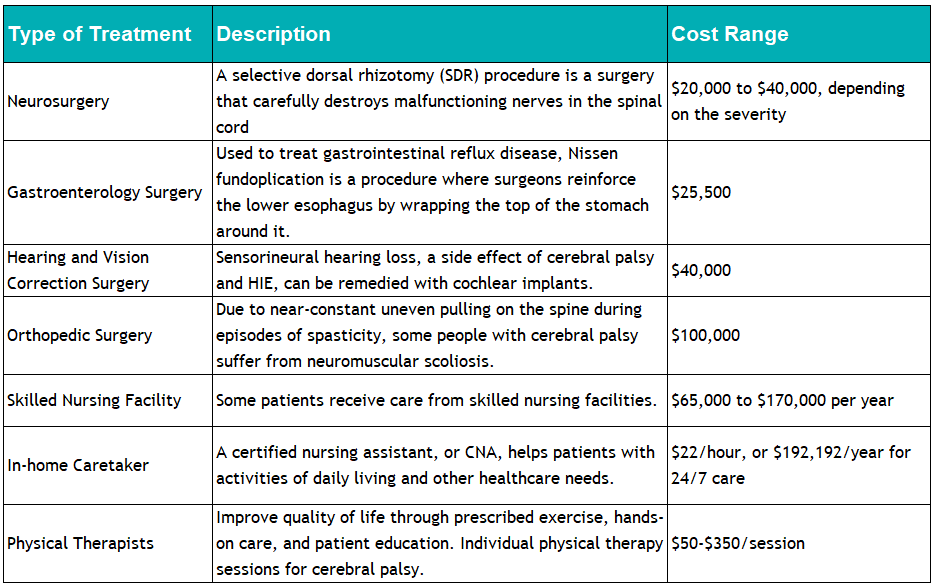
MobilityWorks
Accessibility for all: Helping people connect with who and what matters most
Searching...
No results found. Please try modifying your search.
Out-of-pocket costs for cerebral palsy vary depending on your insurance. Trust Help Hope Live for fundraising.
Are you looking to learn more about cerebral palsy financial assistance and the challenges cerebral palsy can pose? We’re here to help.
Cerebral palsy is a neurological disorder that affects muscle control, movement, and coordination, which can cause a range of symptoms that vary from person to person. In this post, we discuss the Medicare out-of-pocket costs for treatments for cerebral palsy, physical therapies, assistive technologies to help manage symptoms, and how our fundraising efforts can help cover the out-of-pocket costs for cerebral palsy.
There is no laboratory biomarker for cerebral palsy. Instead, it is a clinical diagnosis. Based on a combination of clinical signs, neurological symptoms, and physical limitations, most can reach a diagnosis. Early detection enables timely intervention when the greatest gains are possible from neuroplasticity.
Cerebral palsy early intervention using intense motor learning task-specific approaches, plus environmental enrichment, optimizes natural plasticity and improves children’s motor and cognitive outcomes. Early, regular monitoring and treatment for cerebral palsy can also prevent the onset of hip dislocation, scoliosis, and contracture. Lastly, families prefer early diagnosis, early intervention, and parent-to-parent support.
For more information on chronic illness treatment and expenses, check out our Catastrophic Illness Financial Assistance page.
One study focusing on the economic burden of cerebral palsy in the U.S. found that the average lifetime healthcare cost per patient was $921,000 for individuals living with cerebral palsy.

Sources:
The cost of cerebral palsy can go beyond the physical and emotional toll it takes on patients and their families when out-of-pocket costs become overwhelming. Fortunately, cerebral palsy financial assistance is available.
These are some of the most common costs cerebral palsy families face—and keep in mind insurance typically will not cover 100% of the costs associated with the diagnosis.
The extent of coverage for your cerebral palsy treatment may differ based on your insurance plan and provider. It’s important to talk with your care provider to determine the amount of financial assistance needed.
Fortunately, Medicare pays for most cerebral palsy treatments. Medicare enrollees with cerebral palsy will receive the same services, at the same costs, as other enrollees.
Services do not have to be related to the disability, and services cannot be denied because of the disability. While Medicare covers many costs, there are many out-of-pocket expenses that are incurred, no matter your insurance coverage or insurance premium.
Managing cerebral palsy with health insurance is difficult enough. Dealing with the financial responsibilities can be very costly. According to an estimate from the Center of Disease Control and adjusted for inflation, a parent or guardian of a child with cerebral palsy will pay a lifetime cost of $1.6 million for care.
In 2003, the Centers for Disease Control estimated that lifetime costs of caring for an individual with cerebral palsy are approximately $1 million, in addition to normal living costs. When adjusted for inflation, this amount equates to over $1.6 million as of 2023.
Addressing a cerebral palsy diagnosis is filled with a long list of questions that differ with every situation. All of these unknowns can add to the stress of living with cerebral palsy. Add additional procedures, rehabilitation, therapy, as well as long-term care, and the bills can add up quickly.
Fortunately, we’re here to help.
As your community-based fundraising source, you’ll find everything you need to receive financial support for cerebral palsy treatments. Together, we can raise funds to assist with your unmet medical expenses and related costs.
The fundraising process with our nonprofit starts with a few simple steps:
Help Hope Live differs from GoFundMe by:
We are a nonprofit with more than four decades of fundraising experience and a 4-star Charity Navigator rating.

Eighteen-year-old Ella Weiske is living with spastic quadriplegic cerebral palsy. With the support of her community and Help Hope Live, she raised $40,000 for a key mobility device: a Trexo robotic system. Thanks to her new Trexo, Ella will get the chance to walk across the stage at her high school graduation.
In a 2020 survey, clients and their trusted team members chose these five words to describe how our nonprofit makes a difference. 94% of our clients would gladly recommend Help Hope Live as a resource to another patient or family.
If you choose to fundraise with our nonprofit, here’s how the process will look:
1. APPLY for assistance
2. YOU’LL BE PAIRED with a Client Services Coordinator
3. YOUR COORDINATOR will provide you with one-on-one fundraising help, including personalized fundraising materials and guidance on how to rally your community, share your story on social media, reach out to the press, plan in-person or virtual fundraising events, and more.
Need Other Financial Help Options?
For alternatives to fundraising, you can find information on a variety of cancer financial assistance options. Please view our Catastrophic Illness Resource Directory for insight into sources of direct financial aid, support groups, and other resources for cerebral palsy patients and their families.